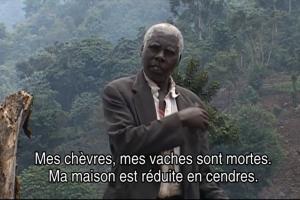Mt. Elgon is an extinct volcano that is the fourth highest mountain in East Africa. The Bagisu and Sabiny are the two ethnic tribes around the mountain. It has a total area of 2,504 Km² in which the protected area of Mt. Elgon covers approximately 2045 Km² with 1145 km2 comprising the Uganda side and 900 km² comprises the Kenyan side. (Source:en.wikipedia.org/wiki/Mount_Elgon_National_Park)
Uganda
Other information
3 August 2008
"My house and goats are dead, my house burned to the ground," recounts a Ugandan farmer at the start of this downloadable film. "My coffee and banana trees were chopped down, and new trees were planted in their place."
"We should bring developing countries on board using a variety of means," counters a Dutch businessman and carbon trader.
Bulletin articles
26 June 2008
In February 2008, the Uganda Wildlife Authority and the Uganda People's Defense Forces evicted more than 4,000 people from the Benet and Ndorobo communities living in Mount Elgon National Park in East Uganda. People's houses and crops were destroyed, cattle were confiscated and the people were left homeless. They found shelter where they could: in caves and under trees. The luckier ones stayed in a primary school or moved in with their relatives.
Other information
2 February 2008
Mount Elgon has seen major land disputes since it was declared a National Park in 1993. Villagers were evicted from the park in 1993 and again in 2002. The area surrounding the park has a high population density and farmers have little choice other than to keep going back into to the park to plant their crops. Violence has flared between the Ugandan Wildlife Authority (UWA), the agency responsible for managing the park, and villagers trying to make a living. Villagers say that UWA officials have threatened them, shot at them and sexually abused them. Several people have been killed.
Bulletin articles
19 May 2007
Uganda has witnessed growing protests in recent weeks over government plans to give over 7,100 hectares of Mabira Forest, a nature reserve since 1932, to SCOUL for sugarcane growing. Razing the forest could devastate a fragile environment, sparking soil erosion, drying up the climate and removing a buffer against pollution for Lake Victoria. Technical, professional and expert advice against the project as well as public protests culminated in the resignation of the Board and senior technical staff of the National Forestry Authority (NFA).
Bulletin articles
26 February 2007
The land near the southern boundary of the Mount Elgon national park is green and the volcanic soils are fertile. But since it was declared a national park in 1993, a sometimes violent conflict between villagers and the national park management has flared up at Mount Elgon.
Bulletin articles
29 December 2006
A Ugandan sugar company plans to expand its sugar estate destroying 7,000 hectares or nearly a third of Mabira forest, one of the few remaining intact forests around the shores of Lake Victoria, home to unique species of monkeys and birds. The plan has proved hugely controversial for threatening hundreds of unique species confined to dwindling patches of rainforest and may affect the rainfall in a region already suffering from drought linked to climate change.
Bulletin articles
29 December 2006
Since 1994, a Dutch organisation called the FACE Foundation has been working at Mount Elgon National Park. FACE works with the Ugandan Wildlife Authority (UWA) which is responsible for the management of national parks in Uganda. The UWA-FACE project aims to plant trees on an area of 25,000 hectares just inside the border of the national park. So far UWA-FACE has planted 8,500 hectares. Under the contract with UWA, the FACE Foundation owns the carbon in the trees planted at Mount Elgon and the trees must not be cut down for at least 99 years.
Publications
22 December 2006
By Chris Lang and Timothy Byakola
Other information
1 August 2006
The accelerated destruction of rainforest and indigenous woodland in Uganda, making way for palm oil and sugar production, follows an all too familiar pattern that has been seen in other parts of the world, especially South Asia.
Widely reported (in the local media) was the government release of five thousand hectares of protected woodlands from its statutory care to BIDCO, a palm-oil producing firm that originates in South Asia, in 2001. These forests, on the Ssese Islands in Lake Victoria were then removed in short order.
Other information
9 December 2005
In 1994, the FACE Foundation signed an agreement with the Ugandan authorities to plant trees on 25,000 hectares inside Mount Elgon National Park in Uganda. FACE is working with the Uganda Wildlife Authority (UWA), which is responsible for the management of Uganda's National Parks.
The FACE Foundation (Forests Absorbing Carbon dioxide Emissions) was set up in 1990 by the Dutch electricity generating board with the aim of planting trees to absorb and store carbon, supposedly to compensate for the greenhouse gas emissions from a new power station to be built in the Netherlands.
Bulletin articles
12 November 2005
The growing trend of establishing plantations of oil palm has taken its toll primarily on tropical forests, where this palm finds enough soil, water and solar energy to fill its needs (see WRM Bulletin 47).
The typical procedure is to log a certain area of forest and then establish the plantation aimed at the production of oil and kernel oil. But it also happens that plantation companies may “clear” the entire forest by setting it on fire –as has been the case with the notorious fires in Indonesia.


